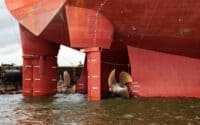Navigating the Waters of Ship Propeller Replacement

We now delve into the intricate world of propeller replacement for ships, massive ships where precision and expertise turn the tide. Handling these giants of the sea requires a deep understanding of the signs of wear, selecting the perfect fit, and the meticulous process of replacement, ensuring these leviathans continue to conquer the oceans with grace and efficiency.
* Please send feedback/suggestions to editor @ shipuniverse.com
Find Your Ideal Ship Propeller Here
Decoding Your Ship’s Propeller Performance
Navigating Through Performance Dips For ship owners, the vessel’s agility and fuel consumption speak volumes about propeller health. When a ship loses its nautical nimbleness and starts guzzling fuel like there’s no tomorrow, it’s often the propeller signaling wear and tear. This isn’t just about operational costs—it’s about the vessel’s heart and efficiency. Keeping a close watch on these signs is crucial for maintaining your ship’s performance and ensuring the longevity of your investment.
The Eye Test: Spotting Propeller Pitfalls A visual check isn’t just a glance—it’s a full examination. Like an experienced captain scanning the horizon, you should scrutinize your propeller for any imperfections. Blades should be free of scars and corrosion, maintaining their original form without any hint of bending or warping. Such damage not only compromises your journey but can also lead to costly repairs down the line.
Feeling the Rhythm: The Vibration Diagnosis A ship in prime condition sails smoothly; excess vibration is a cry for help from below the waterline. If you’re feeling unexpected tremors through the deck, it’s time to dive deeper into the issue. Propeller imbalance could be the culprit, leading to a rough ride and potential damage to the ship’s internal structure. Attending to these vibrations promptly can save you from a sea of trouble.
Underwater Drone Inspections: A Dive into Propeller Health
In the depths where divers can’t always reach, underwater drones, also known as remotely operated vehicles (ROVs), serve as your eyes in the ocean. They enable a thorough check for propeller wear and tear without dry-docking.
Deploying Your Underwater Scout Launching an ROV is like sending a mini-submarine on a reconnaissance mission. It’ll glide around the propeller, feeding live footage back to you, revealing any issues with corrosion, cracks, or marine growth that could spell trouble.
Pinpointing Problems Thanks to high-resolution cameras and maneuverability, drones can spot the smallest imperfections. They can even measure blade thickness or identify areas where the metal has worn thin.
Maintaining Performance This isn’t just about fixing problems. Regular underwater surveillance can catch signs of wear before they impact performance, allowing for proactive maintenance and repairs that keep your ship in shipshape.
An ROV’s detailed survey can offer peace of mind that your propeller is ready to face the vast and unpredictable sea, ensuring your vessel continues to navigate smoothly, efficiently, and safely.
Selecting the Perfect Propeller
Precision Match-Up Dialing in the details is non-negotiable when it comes to propeller replacement. It’s not just about finding a propeller that fits; it’s about sourcing one that harmonizes with your ship’s dimensions, power, and performance profile. Ensuring the pitch, diameter, and material echo the original’s specs is fundamental to maintaining the integrity of your vessel’s operational capabilities.
Contemplating Upgrades The maritime world is not static, and neither should be the technology propelling your ship. Contemporary advancements in materials and design—like composites that reduce weight or innovative blade geometries that boost efficiency—are worth exploring. Upgrading could mean more than just maintaining performance; it could translate into tangible gains in speed, fuel economy, and longevity.
Expert Guidance for Tailored Solutions The sea is a vast expanse, and so are the choices in propeller technology. Consulting with marine engineers or propeller specialists is not just recommended; it’s a step that pays dividends. These experts can help navigate the myriad of options, balancing your ship’s characteristics with the propeller’s features, ensuring a choice that’s not merely good, but optimal for your maritime venture.
Find Your Ideal Ship Propeller Here
The Precision Propeller Replacement Process
Dockyard Protocol Before initiating the replacement, ensure your vessel is securely stationed in a drydock. Adhering strictly to safety protocols is paramount. The ship’s size requires not just precision but also the collective effort of a qualified team to manage the complex process of disassembly and installation.
Dismantling with Care Removing the old propeller from a large ship is a delicate operation that often involves cranes and specialized tools. Every step, from the unbolting of nuts to the handling of the massive blades, demands meticulous attention. Documenting each phase is essential for a smooth transition to the new propeller.
Strategic Installation Attaching a new propeller on a maritime ship is a symphony of engineering precision and teamwork. Correct alignment is crucial, and this is where the expertise of seasoned technicians comes into play, ensuring that the new propeller is in perfect harmony with the ship’s propulsion system.
Validation at Sea The final phase is comprehensive sea trials. These tests are vital to assess the new propeller’s performance and balance. This isn’t a mere test run; it’s a rigorous validation under various operational conditions, ensuring the vessel’s readiness for the demands of the open sea.
Replacing a ship’s propeller at this scale is a significant undertaking that integrates technical expertise, diligent planning, and robust testing to achieve a successful outcome.
Ensuring Longevity After the Swap
After replacing your propeller, the journey towards maintenance and performance begins:
Routine Checks and Balances Keep a diligent schedule for propeller inspections, ensuring adherence to the manufacturer’s maintenance protocols. Regular check-ups help in identifying and mitigating any wear before it becomes a larger issue.
Logbook Accuracy Maintain a detailed log of the replacement process and subsequent maintenance activities. This historical record is invaluable for future inspections, maintenance routines, and if any warranty issues arise.
Performance Vigilance Monitor your vessel’s performance meticulously after the propeller replacement. Any deviations in speed, fuel efficiency, or vibration levels can be early indicators of potential issues, allowing for proactive management to ensure the vessel’s efficiency and safety.

Do you have a Maritime Product or Service that may be of interest to Shipowners? Tell us about it here!
Do you have feedback or insights? Please reach out to editor @ shipuniverse.com


